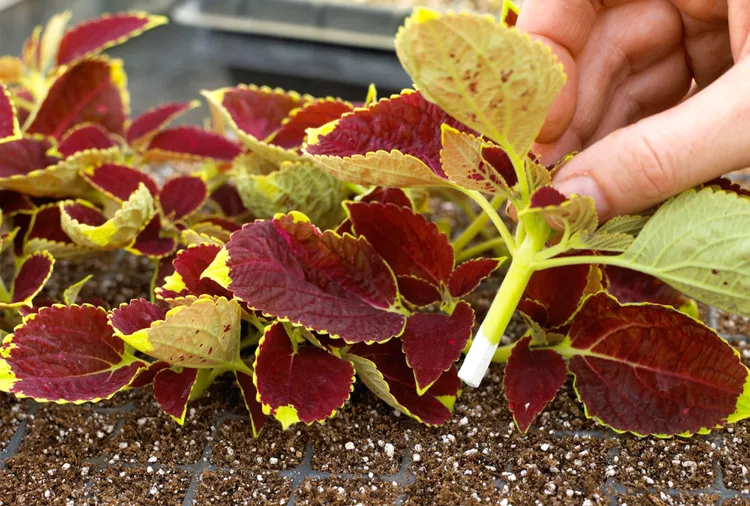What Is Rooting Hormone? Plus How to Use It to Propagate Your Plants

Trying to grow new plants from the cuttings of your existing plants? Break out the rooting hormone. Rooting hormone is usually a substance that you apply to plant cuttings. This hormone speeds the growth of roots that turns your cutting into a new plant. Think of it as a secret weapon in plant propagation. Using a rooting hormone increases the chances that your cuttings of stems and leaves will become plants instead of dying before they grow roots.
Types of Rooting Hormone
Synthetic Rooting Hormone
This chemical is produced commercially and contains indole-3-butyric acid (IBA,) an artificial version of the natural plant hormone auxin. Naphthalene acetic acid (NAA) is another synthetic rooting hormone that slows rotting while stimulating root growth. Synthetic rooting hormones come in a powder, liquid, or gel, and you can buy them from home improvement stores and plant sellers.
Pros: Your cuttings will develop roots faster and more reliably. You’ll look like a propagation pro when you use this stuff.
Cons: Synthetic rooting hormone can irritate your eyes, skin, or respiratory tract if you touch it or inhale it. It’s a caustic chemical, recognized as a pesticide by the Environmental Protection Agency.
Wear gloves when applying synthetic rooting hormone to cuttings, and be careful not to inhale or ingest the material.
Natural Rooting Hormone
Natural rooting hormone is also available commercially and is usually made from ingredients derived from seaweed to promote root growth in cuttings. Most natural rooting hormone contains actual auxin, also known as indole-3-acetic acid (IAA.) Natural rooting powder contains no synthetic growth hormones or fungicides.
Pros: Natural rooting hormones are non-toxic.
Cons: None.
How Rooting Hormone Works
Just as hormones regulate growth in the human body, plants have hormones that regulate their growth and development. Plants have a chemical called auxin that tells them when to grow roots.
Synthetic root hormone products contain compounds that mimic auxin while organic or natural root hormone products contain natural compounds that mimic auxin. In a way, rooting hormone is like replacement hormone therapy for plant cuttings. Some root hormones also contain antifungal agents to slow rot, so a cutting has more time to grow roots.
How to Use Rooting Hormone on Cuttings
With the type of rooting hormone you want to use (powder, gel, or liquid) and the plants you want to propagate in hand, follow these steps:
- Use sharp, clean garden shears or a knife to remove a stem cutting from the growing tip of a healthy plant. Get a cutting that is 3-8 inches long and cut near a node on the stem. The node is a swollen portion of a stem where new growth will emerge.
- Remove leaves or flowers from the nodes on the lower half of the cutting.
- Moisten the bottom inch or two of the cutting with water.
- Pour some rotting hormone into a clean container. Small plant saucers work well for this.
- Dip the moistened end of the plant cutting into the root hormone. (Note: If you choose root hormone in a gel form, you will not need to moisten the stem of the cutting to get the hormone to adhere.)
- Shake off excess powder by lightly tapping the cutting against the edge of the saucer.
- Lightly moisten fresh potting mix in a small container, then make a hole in the mix with a pencil or chopstick that’s wide enough for the plant stem.
- Sink the part of the cutting with hormone on it into the hole and tamp soil around the cutting.
- Keep the cutting warm, 65-75°F is ideal. Put the plant in a bright window in indirect light until it roots, which takes from 2 to 6 weeks, depending on the type of plant.
Tips for Rooting Success
- Plant cuttings in a clear plastic cup. That way you can see the roots when they grow.
- Don’t apply water to the potting mix until you see roots, or you will hasten rot in the cutting.
- To keep the cutting hydrated until it grows roots, mist leaves with a spray bottle. The plant will absorb the moisture through openings in its leaves. You can also place a clear plastic ziptop bag over the cutting to keep humidity high around it, but make sure the bag doesn't touch the plant.
Using rooting hormone makes it much easier to propagate plants from cuttings. The hormone gives cuttings a boost that makes them grow into rooted plants faster, creating stronger, healthier plants. It's especially helpful for rooting hard-to-propagate plants, so is a worthwhile product to keep in your gardening toolbag.